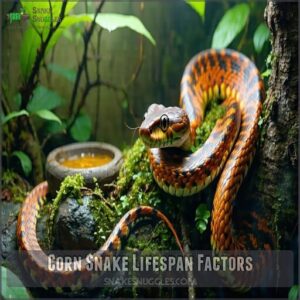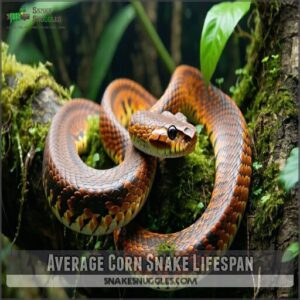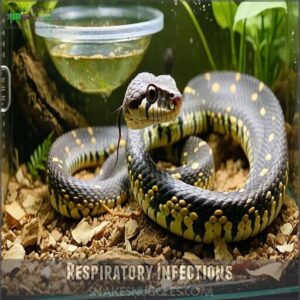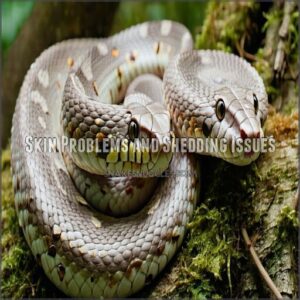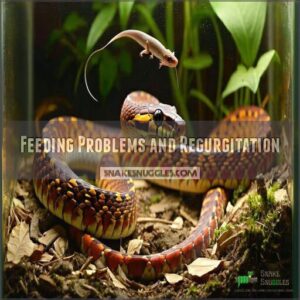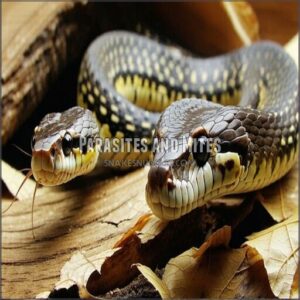This site is supported by our readers. We may earn a commission, at no cost to you, if you purchase through links.
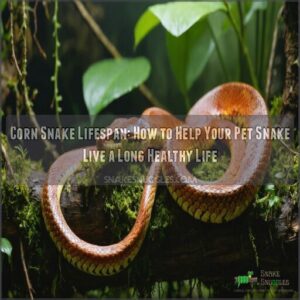
These snakes are hardy and easy-going, but like any pet, they have needs. Good genetics and breeding, a proper diet (say goodbye to feeding myths), and an ideal habitat all play a huge role in their longevity.
In the wild, their life expectancy is shorter, thanks to predators and less predictable conditions.
Treat your corn snake like the mini-scaly treasure it is, and it’ll be around for the long haul. Curious about creating the perfect habitat? Keep reading for tips!
Table Of Contents
- Key Takeaways
- Corn Snake Lifespan Factors
- Average Corn Snake Lifespan
- Ensuring Long Corn Snake Life
- Common Health Issues
- Maximizing Corn Snake Lifespan
- Frequently Asked Questions (FAQs)
- How long can corn snakes be held?
- How long does a corn snake live as a pet?
- Do corn snakes like to be held?
- Are corn snakes aggressive?
- How many times can you hold a corn snake a day?
- Do corn snakes get lonely and need companions?
- Can breeding affect a female corn snakes lifespan?
- What age is considered elderly for corn snakes?
- Do different corn snake morphs have varying lifespans?
- Do corn snakes recognize their owners over time?
- Conclusion
Key Takeaways
- Care for your corn snake properly by providing a clean, stress-free environment with the right temperature (70-85°F) and humidity (40-60%) to ensure it thrives.
- Feed thawed frozen rodents sized to the snake’s width, and follow a proper feeding schedule based on its age to avoid health issues like regurgitation or obesity.
- Regular health check-ups with an exotic vet can catch early signs of illness like respiratory infections or parasites, extending your snake’s lifespan to 20+ years.
- Corn snakes don’t need companions and prefer to live alone, so focus on enrichment activities, like hides and climbing décor, to keep them active and healthy.
Corn Snake Lifespan Factors
Your corn snake’s lifespan depends on several key factors like genetics, diet, and environment, all of which you can control with proper care.
Proper care of genetics, diet, and environment unlocks your corn snake’s full lifespan potential, ensuring many happy, healthy years together.
By understanding these elements, you’ll set your scaly friend up for a healthy, long life, with proper care being crucial.
Genetics and Breeding
Genetics plays a huge role in your corn snake’s lifespan.
Selective breeding creates stunning morphs, but genetic mutations can sneak in.
To guarantee healthy breeding:
- Avoid hybridization risks by sticking to purebred corn snakes.
- Focus on breeding ethics—prioritize health over rare colors.
- Regularly monitor for inherited conditions to maintain robust genetics.
Healthy genes = happier, longer-lived snakes!
Nutrition and Diet
A proper corn snake diet includes feeding frozen rodents, not live ones, to guarantee safety.
Match prey size to your snake’s body width, feeding every 7-14 days.
Avoid dietary supplements unless advised.
For hatchlings, feed smaller, more frequent meals.
| Feeding Stage | Prey Type | Prey Size | Feeding Frequency | Notes |
|---|---|---|---|---|
| Hatchlings | Frozen mice | Pinky-sized | Every 5-6 days | Smaller prey is vital |
| Juveniles | Frozen rodents | 1.5x head width | Every 7-10 days | Gradually adjust size |
| Adults | Frozen rats | Mid-body width | Every 10-14 days | Maintain consistency |
| Sick Snakes | N/A | Veterinary-advised | Case-dependent | Consult a vet for feeding |
| Breeding Season | Frozen rodents | Slightly larger | Weekly or biweekly | Energy boost needed |
Tailoring your snake’s nutrition builds a happy, long life, by providing the right prey size and feeding frequency, and avoiding unnecessary dietary supplements, which is crucial for hatchlings and adults alike, and requires careful consideration during breeding season.
Environment and Housing
A cozy enclosure keeps your corn snake happy.
Choose the right enclosure size and set up a temperature gradient from 70-85°F.
Maintain steady humidity levels (40-60%) and use safe substrate choices like aspen shavings.
Add enrichment items like hides and climbing décor.
Proper husbandry practices are essential for longevity.
A thoughtful habitat setup guarantees your snake stays stress-free, active, and healthy!
Health and Veterinary Care
After setting up the perfect habitat, focus on corn snake health.
Regular visits to an exotic vet guarantee preventative care and early detection of issues like snake parasites or respiratory infections.
Quarantine protocols help reduce disease spread, and recognizing illness signs—like lack of appetite—can save their life.
Keep emergency situations manageable with these snake health tips and reliable veterinary care.
Average Corn Snake Lifespan
Corn snakes can live anywhere from 6 to 8 years in the wild, but with proper care in captivity, they often reach 20 years or more.
With proper care, a corn snake can thrive in captivity, living over 20 years—far surpassing their 6-8 years in the wild.
Understanding their typical lifespan helps you provide the best care to keep your scaly friend healthy and happy for as long as possible.
Lifespan in Captivity
In captivity, corn snakes can live over 20 years, with the record lifespan reaching 32 years.
Several factors influence this incredible longevity:
- Genetic influence on lifespan potential.
- Advances in husbandry and snake care practices.
- Proper nutrition suited to size and age.
- Enrichment impact through stimulating environments.
- Vigilant attention to health and cleanliness.
Good care truly extends a snake’s lifespan!
Lifespan in The Wild
Wild corn snakes face tough odds.
Predation risks, environmental threats, and habitat quality affect their lifespan in the wild, typically 6–8 years.
Limited food availability and natural snake predators like hawks impact survival.
Understanding their ideal temperature gradients is essential for their well-being.
Check out how lifespan factors differ below:
diseases
The factors influencing the snakes’ survival are interconnected, with predation risks, habitat quality, and food availability playing crucial roles.
These elements, along with environmental threats and genetic diversity, contribute to the snakes’ overall lifespan in the wild.
Comparison to Other Snake Species
When comparing snake lifespan across species, corn snakes stand out with 20+ years in captivity, surpassing many others.
Their even temperament, manageable size, and adaptable diet contribute to this longevity. While habitat differences and diet comparisons play a role, larger snakes like boas often outlive corn snakes, reflecting variations in reptile lifespan.
Each snake species has unique needs influencing its longevity.
Ensuring Long Corn Snake Life
To help your corn snake live a long and healthy life, focus on providing proper care, from housing to nutrition.
By meeting its needs and reducing stress, you’ll set your pet up for many happy years ahead.
Proper Housing and Environment
A proper enclosure promotes long corn snake life.
Choose the right enclosure size; a 40-gallon tank suits adults.
Maintain a temperature gradient: 85°F warm and 70°F cool ends.
Keep humidity levels at 40-60%.
Use safe substrate choices like Aspen shavings.
Add enrichment items such as hiding spots and climbing structures to mimic their natural habitat, ensuring superior snake care.
Regular cleaning helps reduce potential health risks to support a long and healthy snake life.
Nutrition and Feeding Guidelines
A healthy corn snake diet includes feeding thawed frozen rodents sized about 1.5 times the width of your snake’s head.
Stick to a feeding frequency of every 5-7 days for hatchlings and 7-14 days for adults.
Avoid overfeeding to prevent obesity.
Proper feeding requires quality reptile supplies to maintain the snake’s health.
Supplementation needs are minimal, but always monitor prey size and feeding routines to support proper digestion and growth.
Regular Health Check-Ups
Vet visits are a cornerstone of snake care, ensuring early detection of snake diseases and extending your corn snake’s lifespan.
Preventative care like annual check-ups and weight management keeps snake health on track.
A good reptile care routine includes health monitoring for changes in appetite, skin, or behavior.
Prioritize reptile health products for superior care. Don’t skip these simple steps—they make all the difference!
Handling and Stress Reduction
Frequent handling builds trust, but overdoing it stresses your corn snake.
Recognize stress signs like hissing or rapid movements. Safe handling means supporting their body and avoiding sudden moves.
Stick to 10-15 minutes per session, a couple of times a week, for happy handling.
- Tips for reducing stress includes snakes need
Common Health Issues
Your corn snake’s health can impact its lifespan, so knowing the common issues is key to catching problems early.
From respiratory infections to pesky mites, understanding these challenges helps you keep your snake happy and healthy.
Respiratory Infections
Respiratory infections (RI) can sneak up on your corn snake, affecting its health.
Look for RI symptoms like wheezing, excess mucus, or frequent yawning. Keep humidity balanced (40-60%) to avoid issues.
Use quarantine for sick snakes and adjust the enclosure’s temperature to aid recovery. Proper RI prevention and treatment keep your snake breathing easy.
| Possible Causes | Prevention |
|---|---|
| Low humidity | Maintain 40-60% RI humidity |
| Cold temperatures | Keep enclosure warm |
| Dirty enclosure | Spot-clean weekly |
| Prolonged stress | Reduce handling |
| Poor air circulation | Verify ventilation |
Skin Problems and Shedding Issues
Shedding can get tricky if your corn snake faces stuck shed or dysecdysis. Improper humidity levels, poor habitat care, or infections like scale rot cause issues.
Signs include retained eye caps or dry patches.
To help:
- Keep humidity at 40-60%, boosting it during sheds.
- Provide a moist hide box.
- Gently soak stubborn areas using warm water.
Feeding Problems and Regurgitation
If your corn snake spits up its meal, it’s likely regurgitation.
Common causes include improper feeding frequency, stress, or prey size being too large.
Verify the prey matches the snake’s mid-body width and give ample rest after feeding.
Food refusal can hint at seasonal changes or health issues.
Adjust the diet gradually and consider necessary supplementation needs to maintain health and address potential stress.
Parasites and Mites
After addressing feeding problems, it’s worth discussing mites and parasites in corn snake care.
Mites, tiny pests causing skin irritation, can stress your snake, especially during shedding issues.
Parasite prevention, like keeping habitats clean, helps, and for mites or internal parasites, seek veterinary diagnosis for treatment options.
Stay consistent with health checks—your snake’s long, lively years depend on it.
Maximizing Corn Snake Lifespan
You can help your corn snake live a long, healthy life by minimizing stress, providing a stimulating environment, and staying informed about proper care.
Small, consistent efforts in these areas make a big difference in their overall well-being.
Creating a Stress-Free Environment
To help your corn snake thrive, focus on stress-free pet snake care.
Create quiet zones in their enclosure, avoiding loud noises or sudden movements.
Safe handling is key—support them gently to reduce discomfort.
Incorporate Enclosure Enrichment that mimics natural behaviors, like hides or branches.
Consider enrichment products for snakes to further stimulate their environment.
Stick to a consistent routine for feeding and cleaning to keep things predictable, ensuring a calm and predictable environment.
Providing Mental Stimulation and Exercise
Your corn snake thrives with a mix of activity and novelty. Enrichment ideas include climbing branches and sensory-stimulating textures.
Try these for mental stimulation and exercise:
- Add habitat complexity with tunnels or hideout boxes.
- Encourage snake exploration by rearranging enclosure décor.
- Offer occasional handling benefits outside the enclosure.
- Rotate objects to spark curiosity and test their climbing ability.
Remember to maintain proper humidity levels for ideal health.
Staying Up-to-Date on The Latest Care and Research
Staying informed about corn snake care is key to snake longevity.
Keep an eye on new care techniques and research publication alerts. Join expert veterinary forums for updated snake care guidelines and breeding program updates.
Monitoring conservation status updates can help too. Knowledge evolves, so staying engaged guarantees your corn snake enjoys the longest, healthiest snake lifespan possible, with proper care being essential for longevity.
Frequently Asked Questions (FAQs)
How long can corn snakes be held?
Think of it like borrowing a shy friend’s time—corn snakes tolerate handling in short sessions of 10-15 minutes.
Too long might stress them out, so keep it brief and let them rest.
How long does a corn snake live as a pet?
As a pet, your corn snake can live 15-20 years or longer with proper care.
Provide a healthy diet, clean environment, and attention to temperature and humidity to keep them thriving for decades.
Do corn snakes like to be held?
Corn snakes aren’t exactly cuddly, but they tolerate handling well.
Regular, gentle interactions can help them relax, but don’t overdo it—too much handling might stress them out, especially right after eating or during shedding.
Are corn snakes aggressive?
No, corn snakes aren’t aggressive.
They’re actually quite docile and easygoing.
If startled, they may hiss or shake their tail, but they rarely bite.
With gentle handling, they quickly become comfortable around you.
How many times can you hold a corn snake a day?
You can handle your corn snake 1-2 times a day, for about 10-15 minutes each time.
Just make sure your snake isn’t stressed, recently fed, or shedding, as these times require extra care.
Do corn snakes get lonely and need companions?
You might wonder if they feel lonely, but corn snakes thrive solo.
They’re natural loners, prefer their own space, and don’t need snake buddies.
Adding a companion could even stress them out—better safe than sorry!
Can breeding affect a female corn snakes lifespan?
Breeding can shorten a female corn snake’s lifespan due to the physical stress of egg production.
Frequent breeding, poor nutrition, or inadequate care increases risks.
Provide proper care and spacing between clutches to keep her healthy.
What age is considered elderly for corn snakes?
A corn snake is considered elderly around 12-15 years old.
At this stage, they slow down a bit, and care adjustments, like maintaining an ideal environment and monitoring health closely, can really help them thrive.
Do different corn snake morphs have varying lifespans?
Think of lifespan like a well-tuned clock—consistent across morphs.
Morphs don’t impact how long a corn snake lives.
Their care, environment, and diet determine if they’ll thrive for 15-20+ years in captivity.
Do corn snakes recognize their owners over time?
Corn snakes don’t recognize owners like dogs or cats, but they can get accustomed to your scent and handling over time.
With regular interaction, they’ll feel secure and more comfortable in your care.
Conclusion
Think of your corn snake’s lifespan like a well-tuned car—it thrives with the right fuel, regular maintenance, and a safe garage.
By focusing on proper care, from its diet to creating an ideal habitat, you’ll help your scaly companion hit 15 to 20 years with ease.
Don’t skip on health check-ups or stress reduction either—these small actions make a big difference.
Treat your corn snake with attention and care, and it’ll stay a vibrant part of your life for years.

